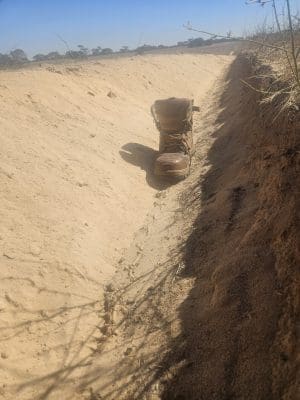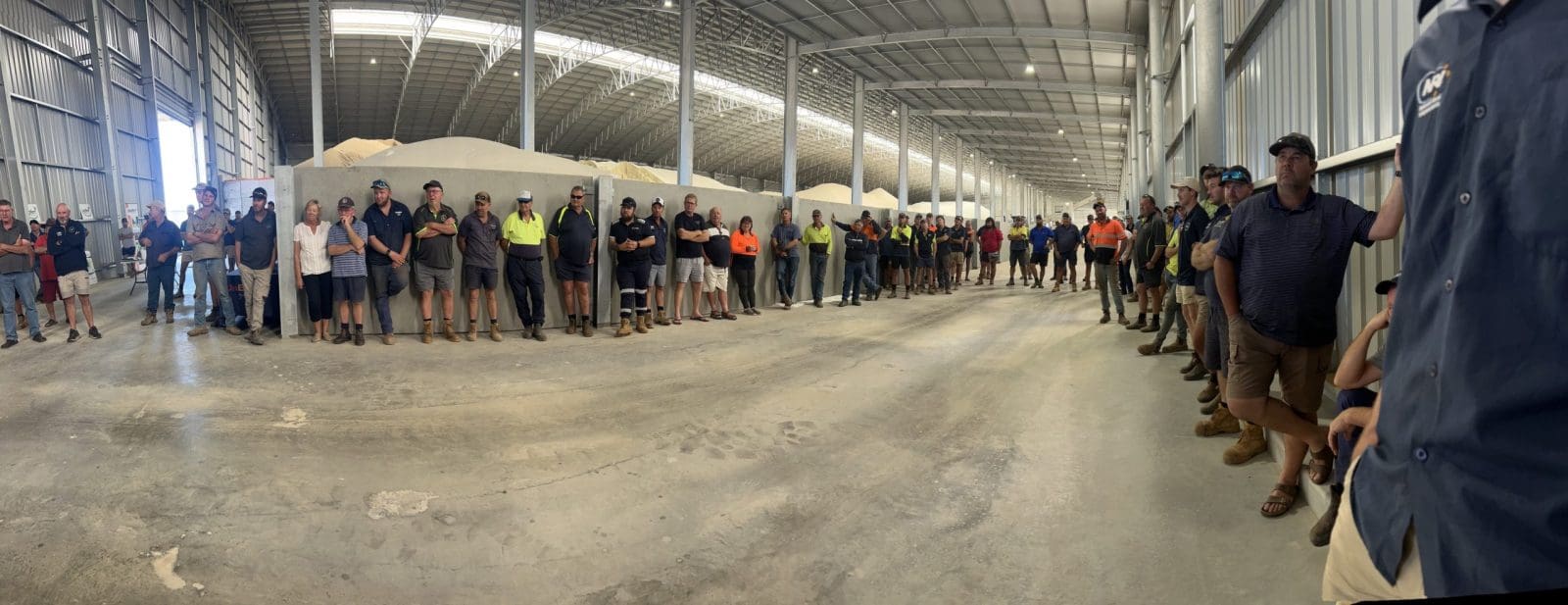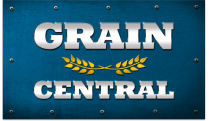
The SA Government held a drought roundtable yesterday to speak with primary industries ahead of the next phase of its Drought Support Package. Photo: Peter Malinauskas
THE SOUTH Australian Government yesterday convened a roundtable to guide the next phase of its Drought Support Package as SA’s primary producers remain in the grips of what for many is the driest period in living memory.
In attendance from the SA Government were Premier Peter Malinauskas, Treasurer Stephen Mullighan, and Minister for Primary Industries Clare Scriven.
Industries represented included cropping, grazing, and horticulture, and Grain Producers SA chief executive officer Brad Perry said the roundtable demonstrated the government’s understanding that more needs to be done to support industries during this drought.
“It’s the first time we’ve had a roundtable with the premier, and yesterday, the decision-makers were in the room,” Mr Perry said.

A deep furrow left by a Plozza disc plough to ameliorate constrained soils shows how dry the profile is at Netherton in SA’s Murraylands. Photo: Marrett Farms
Waikerie graingrower Tim Paschke was one of a number of primary producers involved in the roundtable to explain to the SA Government representatives what is needed, and why.
“It was an in-depth discussion that went for a couple of hours with a lot of ag industries.
“We’re expecting further support will be announced in coming days.”
“Growers are now making decisions on whether they’re going to sow or not, and that’s why support needs to come sooner rather than later.
“That’s what I personally stressed to the premier; any support needs to come now.”
Standard, drought bills need paying
No insights are available as the nature of SA Government aid to come in the latest drought package, but it could include transport subsidies for fodder donated or bought from interstate, and support for fixed costs such as local government rates and finance repayments.
In a statement released last month, Vater Machinery, in partnership with CNH Capital, said it had continued to tailor financing for its customers aimed aiming to remain viable long-term in the wake of the 2024 harvest which yielded much less than average for most growers.
“CNH have talked with our customers where necessary about bespoke finance packages to make sure that their purchase won’t burden them when the season is tough,” Vater Machinery principal Roger Vater said.
“That might mean farmers only pay interest for 12 months, or come to some other arrangement; we’re happy to support our New Holland customers through CNH Capital to do so.”

CNH Industrial general manager Australia Brandon Stannett and director agriculture ANZ Aaron Bett with Vater Machinery principal Roger Vater (centre). Photo: CNH
Plantback considerations
At Saddleworth in the Mid North, Roger Vater’s brother Kim Vater is the principal trader at AW Vater & Sons, and said rotation decisions may be complicated by the plantback risks tied to herbicides that were applied in 2024 and have had insufficient rain to activate.
“The biggest problem we face is chemical residual carryover,” Mr Vater said.
“There could be a lot of Clearfield used, and then there’s availability of seed.”
Clearfield varieties are resistant to imidazolinone herbicides, which may be needed to spray weeds that will germinate at the same time as the dry-sown crop.
Most paddocks have not had enough rain over summer to spark a germination, and allow growers to clean up their fallows ahead of planting.
Hope springs eternal
Anecdotally, SA orders for fertiliser in the state’s eastern region are said to be down significantly on where they normally are, partly because the low-yielding 2024-25 crop is expected to have left some nitrogen behind for this year.
Kim Vater said fertiliser sales were ticking along, but sales of soil ameliorants as non-essential inputs are slow.
“Our sales of ag lime and gypsum are way down on where they normally they.”
“The fear is there’ll be a big rush on fertiliser once it rains.”
The rule of thumb for the minimum seasonal break in SA, ideally in April, is 25mm over three days or 30mm over seven days.
Despite the lack of soil moisture and forecast rain, many growers across SA have started dry sowing, banking on the break that in nearly all years makes SA a volume producer and exporter of crops including wheat, barley, lentils, faba beans, canola, and hay.
SA family company Agfert Fertilizers recently opened its facility at Cowell on Eyre Peninsula, SA’s western cropping region, and has unloaded four vessels at Whyalla to date to stock its sheds with MAP, DAP, sulphate of ammonia, and urea in time for seeding.
“Our shed’s choc-a-block and we’ve been busy dispatching to farms,” Agfert chief business growth and relations officer Tim Gurney said.
“Some farmers have started seeding, and a lot of the guys with larger programs will start in the first, second, and third week of April, especially to get feed in while the soil’s still warm.”

A group of Eyre Peninsula growers visited Agfert’s recently opened Cowell facility this week as dry sowing starts to ramp up. Photo: Cleve Rural Traders
Mr Gurney said that will predominantly be barley for sheep to graze during winter, and will germinate on 10-15mm of rain.
While cereals and canola require nitrogen from germination, the lentil requirement is more for top dressing, and Mr Gurney said indications are that EP will produce another large lentil crop this season.
“We’re looking for potentially another urea vessel in a couple of months to supply that top-dressing demand.”
Without rain, Mr Gurney said some growers are holding back 5-10pc or their normal cropped area.
“A few guys have reduced the hectares in their program, and are waiting for rain.”
Torrential rain which fell recently in south-west Queensland is now making its way to Lake Eyre, and Mr Gurney said the “old-timers” say that points to good seasons on the way for SA.
“Once Lake Eyre fills, that changes the climate for SA for a couple of years by instigating rain.”
Let’s hope so.
Livestock sector hurting
Livestock SA CEO Travis Tobin attended Wednesday’s roundtable, along with South East member, consultant, and prime lamb and beef producer Elke Hocking.
“Measures such as an additional round of on-farm infrastructure funding, increased access to mental health and farm business support services, faster processing times for available support, and rebates to reduce the cost of doing business in the short term and regulatory reform to reduce this cost longer term were put forward,” Mr Tobin said.
Livestock production occurs on 84 percent of SA’s agricultural land, and while much of its normally arid north has enjoyed good rain in recent months, drought is affecting much of the rest of the state across different production systems.
“Producers are dealing with the cumulative impacts of the post-COVID cost of doing business increase, the livestock price collapse through 2023, and successive drought years – in some areas, the worst on record.
“We understand that the government is finalising a second drought support package and look forward to hosting the Premier on a drought tour to speak directly with more impacted producers soon.”
Organisations including Rural Aid and Aussie Hay Runners have already delivered hay to many SA producers, and the upcoming drought package is expected to include further support for desperately needed fodder as SA stocks run low.

Charities have brought hundreds of truckloads of hay into SA to help alleviate the impact of the drought, and many more are expected with support from the next SA Government drought package. Photo: Aussie Hay Runners
In a statement issued on March 16, Aussie Hay Runners said its most recent hay run to SA transported 106 truckloads of donated fodder to multiple local government areas, supporting more than 130 primary producers, and made possible through the financial support of the Malinauskas Government.
“Without the government’s fodder transportation subsidy, this critical relief effort would not have been
achievable.
“We are currently working alongside the Minister (Clare Scriven), who has been directly engaged with us to understand the current impacts on South Australian farmers and ensure that support reaches those in need.
Aussie Hay Runners has 200 truckloads of donated fodder available to support SA producers who have contacted the organisation looking for assistance.
“We have also advocated for additional transportation subsidy funding to be shared among all charity hay runners
to help cover freight costs and support our efforts.
“Furthermore, we acknowledge and appreciate the many other charities and organisations working tirelessly in this space supporting South Australian primary producers.
“Collaboration, not division, is key to ensuring the best outcomes for our rural communities.”

HAVE YOUR SAY